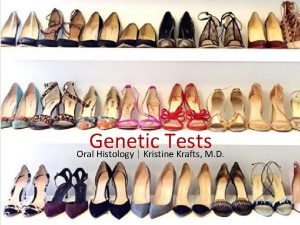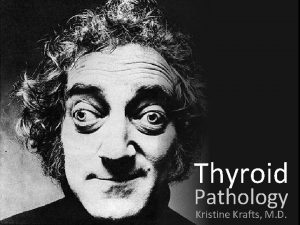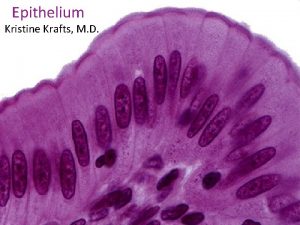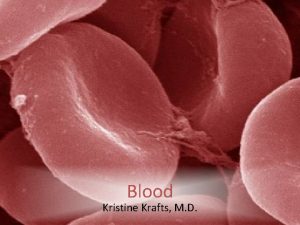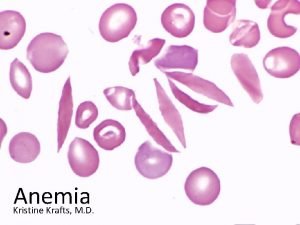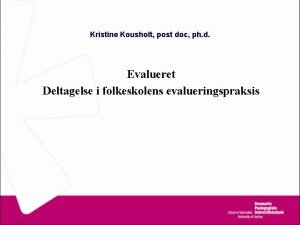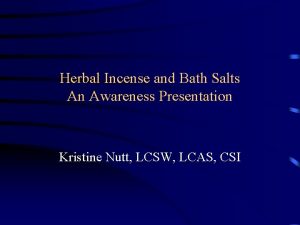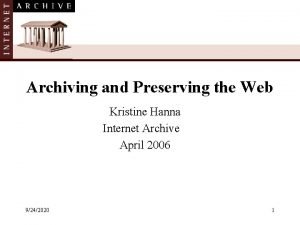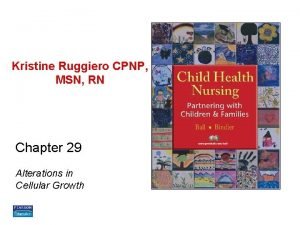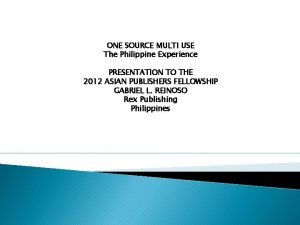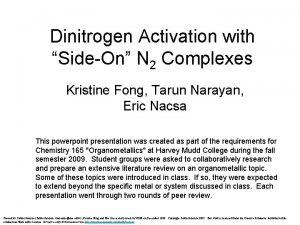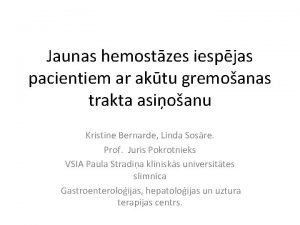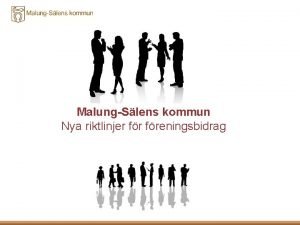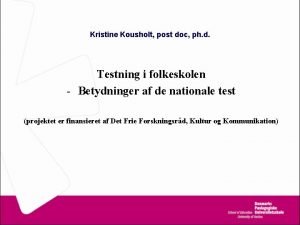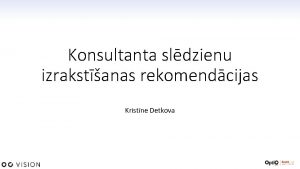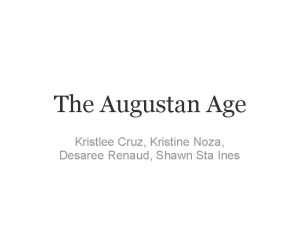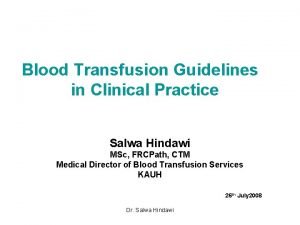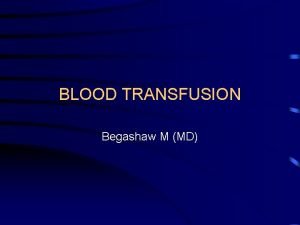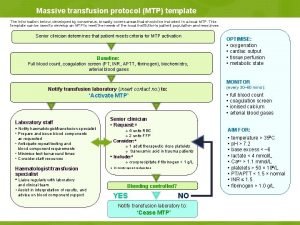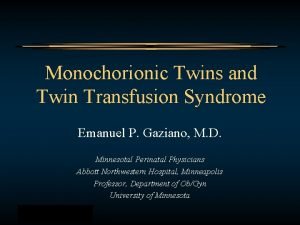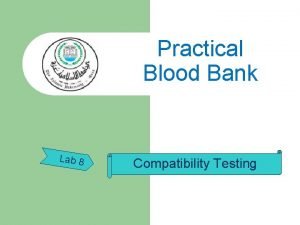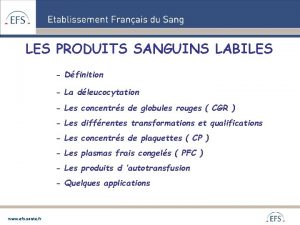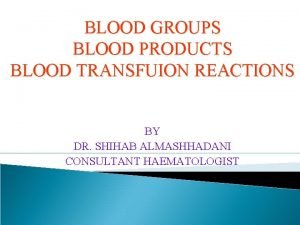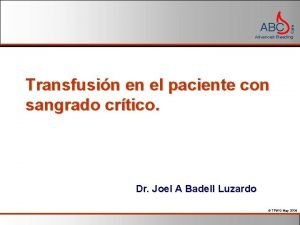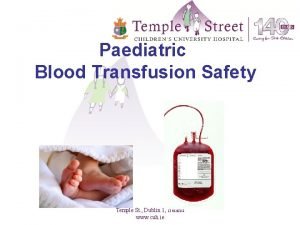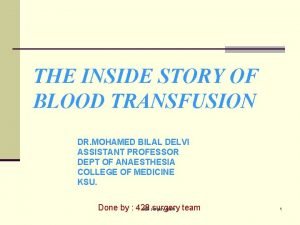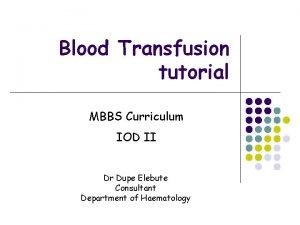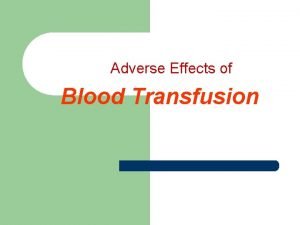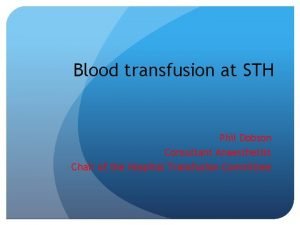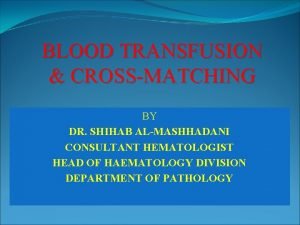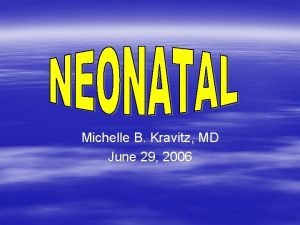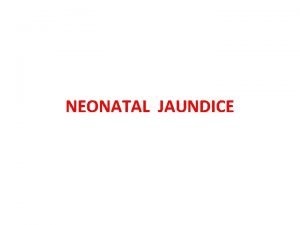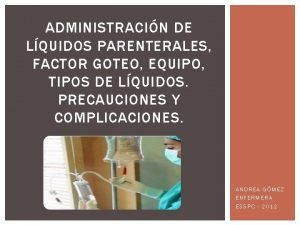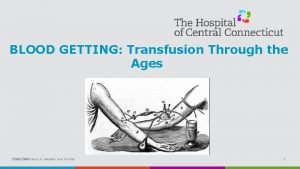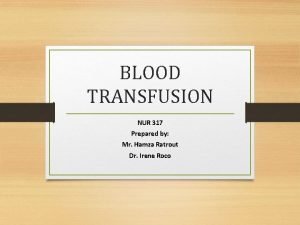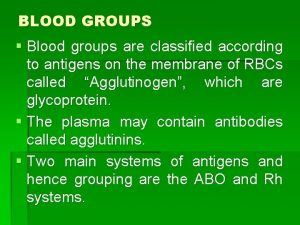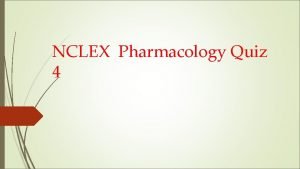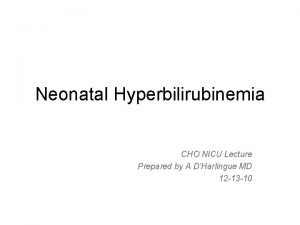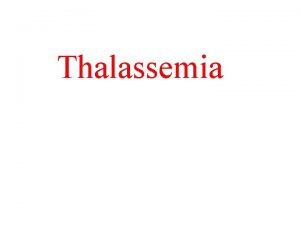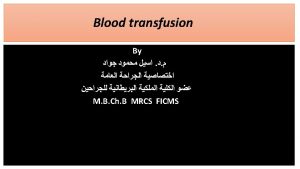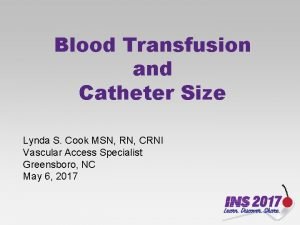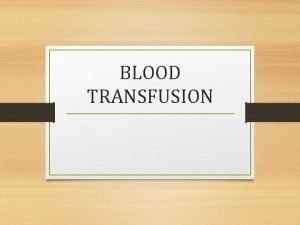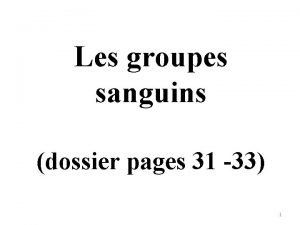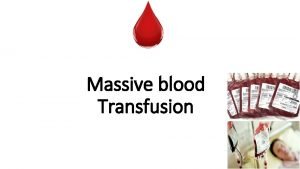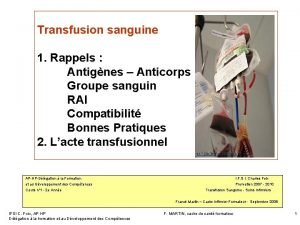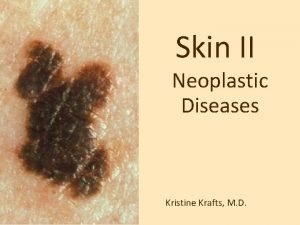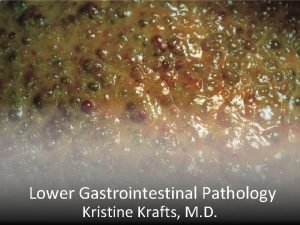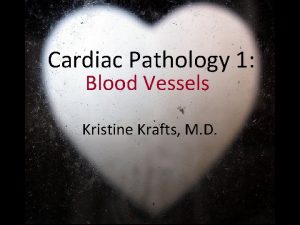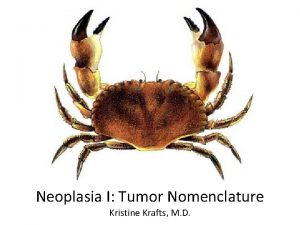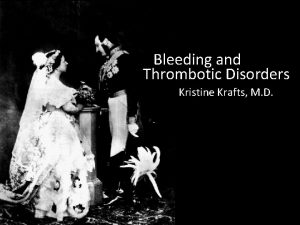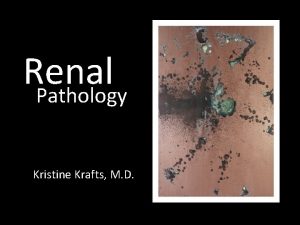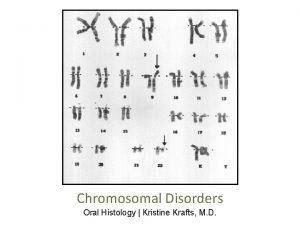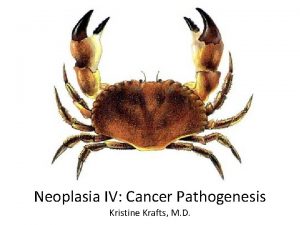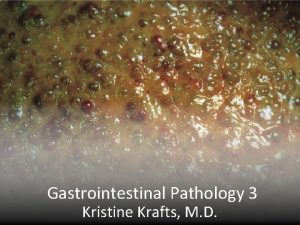Transfusion Medicine Kristine Krafts M D Transfusion Medicine






























































- Slides: 62

Transfusion Medicine Kristine Krafts, M. D.


Transfusion Medicine Outline • Blood groups • Introduction • ABO system • Rh system • Other systems • Blood transfusion • Blood products • Testing • Dangers

Transfusion Medicine Outline • Blood groups • Introduction

Q. What determines a blood group?

Q. What determines a blood group? A. The antigens on the red cell surface.

Red Cell Antigens • Antigens are inherited (Mendelian pattern) • Real function unknown • Damn important during transfusion • Lots of antigens exist (grouped into systems) • Most important systems: ABO and Rh

Transfusion Medicine Outline • Blood groups • Introduction • ABO system

What are the antigens? • A and B • Some people have A antigen (“type A”) • Some people have B antigen (“type B”) • Some people have both A and B (“type AB”) • Some people have neither A nor B (“type O”)

Type A Type B Type AB Type O

How do you make the antigens? • Start with a protein precursor • Add fucose to make H antigen • Add N-acetylgalactosamine to H Ag to make A Ag • Add galactose to H Ag to make B Ag

H antigen A antigen B antigen

What are the genes? H gene • Everyone* has this one • Codes for an enzyme that makes H antigen A, B, and O genes • Everyone has two genes • Six possible genotypes: AA, BB, AO, BO, OO • A and B code for enzymes that make A and B antigens • O has no gene product. * * Almost

Genotype Antigens Blood type A A B B AB A and B AB OO None O AA AO BB BO

How common is each blood type? Blood type Percent of population A 40% B 12% AB 6% O 42%

So what? • We have antibodies to the antigens we don’t have! • Anti-A antibodies lyse type A red cells. • Anti-B antibodies lyse type B red cells. • This is very important during blood transfusion.

Type A Type B Type AB Type O

Blood type Antibodies A A anti-B B B anti-A A and B AB none O anti-A anti-B Genotype Antigens AA AO BB BO AB OO None

Compatible blood types Recipient blood type Donor blood type A A or O* B B or O AB AB, A, B, or O O O * type O = universal d. Onor!

O A B AB

Transfusion Medicine Outline • Blood groups • Introduction • ABO system • Rh system

What are the antigens? • Most important antigen: D! • “Rh” because discovered using Rhesus monkeys. • “Rh factor” refers to the D antigen. • Two alleles: D and d. • People with the D allele make D antigen and are Rh+.

Genotype Antigens Blood type DD D Rh + Dd D Rh + dd none Rh -

What are the antibodies? • Antibodies in this system are acquired! • To make anti-D you must: 1. lack the D antigen on your red cells 2. get exposed to D + blood • Donor and recipient are tested for the D antigen.

Transfusion Medicine Outline • Blood groups • Introduction • ABO system • Rh system • Other systems

Don’t tell me there are more systems. • There a almost a sh*tload of other systems. * • These are not included in routine testing. • Antibodies to antigens in these systems are usually acquired (like anti-D), so unless a patient has been transfused or pregnant, you don’t need to worry too much. * Not quite: a sh*tload is defined as more than 42.


Transfusion Medicine Outline • Blood groups • Introduction • ABO system • Rh system • Other systems • Blood transfusion • Blood products

What do you mean, products? • In olden times, there was only whole blood. • Now, we separate blood into its components • Better for the patient • Conserves blood supply

What are the products? • Whole blood • Red cells • Platelets • Granulocytes • Cryoprecipitate • Fresh frozen plasma

Apheresis donation

BLOOD PRODUCTS Whole Blood Red Cells Granulocytes Platelet-Rich Plasma

BLOOD PRODUCTS Whole Blood Contents: RBC WBC platelets plasma Use: massive hemorrhage

BLOOD PRODUCTS Whole Blood Red Cells RBC Contents: a few WBC a few platelets a little plasma Use: low hemoglobin

BLOOD PRODUCTS Whole Blood Red Cells Granulocytes Contents: neutrophils Use: sepsis in neutropenic patients

BLOOD PRODUCTS Whole Blood Red Cells Granulocytes Platelet-rich plasma

BLOOD PRODUCTS Whole Blood Red Cells Granulocytes Platelets Contents: platelets Use: bleeding due to thrombocytopenia Platelet-Rich Plasma

BLOOD PRODUCTS Whole Blood Red Cells Granulocytes Platelet-Rich Plasma Fresh Frozen Plasma Contents: (including all coagulation factors) Use: bleeding due to multiple factor deficiencies (e. g. , DIC)

BLOOD PRODUCTS Whole Blood Red Cells Granulocytes Platelet-Rich Plasma Platelets Fresh Frozen Plasma Cryoprecipitate fibrinogen Contents: von Willebrand factor VIII XIII Use: low fibrinogen, v. W disease, hemophilia A, XIII deficiency

BLOOD PRODUCTS Whole Blood Red Cells Granulocytes Platelet-Rich Plasma Fresh Frozen Plasma Cryoprecipitate VIII Use: hemophilia A

BLOOD PRODUCTS Whole Blood Red Cells Granulocytes Platelet-Rich Plasma Fresh Frozen Plasma Cryoprecipitate VIII IX Use: hemophilia B

BLOOD PRODUCTS Whole Blood Red Cells Granulocytes Platelet-Rich Plasma Fresh Frozen Plasma Cryoprecipitate VIII IX Albumin Use: hypovolemia with hypoproteinemia

BLOOD PRODUCTS Whole Blood Red Cells Granulocytes Platelet-Rich Plasma Platelets Fresh Frozen Plasma Cryoprecipitate VIII IX Albumin Iv. IG Use: disease prophylaxis, autoimmune disease, immune deficiency states

Transfusion Medicine Outline • Blood groups • Introduction • ABO system • Rh system • Other systems • Blood transfusion • Blood products • Testing

FORWARD TYPE anti-A antibodies AHG patient red cells (type A) Forward typing is done using both anti-A and anti-B antibodies!

REVERSE TYPE reagent red cells (type B) AHG patient serum (with anti-B Ab) Reverse typing is done using both type A and type B reagent cells!

CROSSMATCH patient serum donor RBC AHG

Transfusion Medicine Outline • Blood groups • Introduction • ABO system • Rh system • Other systems • Blood transfusion • Blood products • Testing • Dangers

What can go wrong? • Transfusion reactions • hemolytic • non-hemolytic • Other complications • infections • circulatory overload • iron overload

Acute Hemolytic Transfusion Reactions • Happen when patient has ABO antibodies against the donor red cells. • Most common reason: clerical error! • Symptoms: fever, chest pain, hypotension. • Hemoglobin in serum, urine. • Labs: haptoglobin, bilirubin, DAT positive. • Type and cross-match shows ABO mismatch.


Delayed Hemolytic Transfusion Reactions • Hemolysis occurs days after transfusion. • Caused by antibodies to non-ABO antigens. • Hemolysis usually extravascular. • Presentation: falling Hgb after transfusion. • Usually not severe. • DAT +. Antibody screen identifies the antibody.

Febrile Transfusion Reactions • Caused by recipient antibodies against donor WBC. • Cytokines → fever, headache, nausea, chest pain. • Diagnosis: rule out everything else • Treatment: Tylenol. Leukocyte-reduced components.

Allergic Transfusion Reactions • Probably a host reaction to donor plasma proteins • Symptom: hives • Treatment: antihistamines • Rarely, reaction is severe (anaphylaxis)

What do you do if you suspect a transfusion reaction? • Stop the transfusion! • Check if right blood went to right patient • Monitor vitals • Send blood, urine, and bag to blood bank

What does the lab do? • Check paperwork • Look for hemoglobinuria • Do a DAT • Repeat ABO, Rh testing

Infections • Transfusion-related bacterial infection is an uncommon but serious risk. • Patients suddenly develop fever and shock. • Patient – and blood unit – must be tested. • Treatment: aggressive resuscitation and antibiotic therapy.

Infections • Donor tests: HIV, HTLV, Hepatitis B and C, syphilis. • Despite testing, these diseases are still transmitted. • Other transmissible infections: • viruses (EBV, CMV) • parasitic diseases (malaria, Lyme disease)

Circulatory Overload • Happens when too much blood is given too quickly • Symptoms: hypertension, congestive heart failure • Stop transfusion, give diuretics

Iron Overload • Too much iron can damage heart, liver • Patients with chronic anemias are at biggest risk • Give iron-chelating agents

What’s the risk of getting an infection? Bug Bacterial infection Hepatitis B Hepatitis C HIV Risk One in 50, 000 - 500, 000 * One in 300, 000 One in 2 million * 1 in 50, 000 platelet transfusions; 1 in 500, 000 RBC transfusions

What’s the risk of other complications? Complication Risk Allergic reaction One in 100 (severe: one in 20, 000) Febrile reaction One in 200 Circulatory overload One in 3, 000 Delayed hemolysis One in 4, 000 (fatal: one in 4 million) Acute hemolysis One in 20, 000 (fatal: one in 600, 000)
 Chromosome 9
Chromosome 9 Kristine krafts
Kristine krafts Where is microvilli found
Where is microvilli found Bullous pemphigoid on hands
Bullous pemphigoid on hands Kristine krafts
Kristine krafts Kristine krafts md
Kristine krafts md Kristine krafts md
Kristine krafts md Sahar anwar
Sahar anwar Apocalypse herbal incense
Apocalypse herbal incense Kaitlin bonner
Kaitlin bonner Kristine hanna
Kristine hanna Kristine ruggiero
Kristine ruggiero Panday (2005 tv series)
Panday (2005 tv series) Kristine atiyeh
Kristine atiyeh Kristine fong
Kristine fong Kristine casey
Kristine casey Kristīne bernarde
Kristīne bernarde Kristine brosjö
Kristine brosjö Oppstartfinansiering
Oppstartfinansiering Kristine tveit
Kristine tveit Kristīne madelāne
Kristīne madelāne Bo bendtsen
Bo bendtsen Sahar anwar
Sahar anwar Kristīne freiberga
Kristīne freiberga Kristine nagel
Kristine nagel Kristīne detkova
Kristīne detkova Dr noza
Dr noza Blood transfusion table
Blood transfusion table Blood grouping and crossmatching
Blood grouping and crossmatching Massive transfusion protocol template
Massive transfusion protocol template Monochorionic monoamniotic twins
Monochorionic monoamniotic twins Pretransfusion testing
Pretransfusion testing Whats a platelet transfusion
Whats a platelet transfusion Compatibilité transfusion plaquettes
Compatibilité transfusion plaquettes Blood transfusion groups
Blood transfusion groups Transfusion plaquetas indicaciones
Transfusion plaquetas indicaciones Name that
Name that Blood transfusion requirements
Blood transfusion requirements Febrile nonhemolytic transfusion reaction
Febrile nonhemolytic transfusion reaction When do you transfuse blood
When do you transfuse blood Blood transfusion
Blood transfusion Hemolytic transfusion reaction
Hemolytic transfusion reaction Fresh frozen plasma transfusion time
Fresh frozen plasma transfusion time What are the complications of blood transfusion
What are the complications of blood transfusion Corcider
Corcider Bhutani curve
Bhutani curve Kernectirus
Kernectirus Factor goteo de macrogoteo
Factor goteo de macrogoteo Coconut water transfusion
Coconut water transfusion Nursing responsibility in blood transfusion
Nursing responsibility in blood transfusion Indications for blood transfusion in anemia
Indications for blood transfusion in anemia Platelet concentrate
Platelet concentrate Blood transfusion steps nclex
Blood transfusion steps nclex Chonicu
Chonicu Super transfusion
Super transfusion Transfusion reaction
Transfusion reaction Indications for platelet transfusion
Indications for platelet transfusion Rbc
Rbc Nurses notes for blood transfusion
Nurses notes for blood transfusion Système abo
Système abo Massive transfusion protocol
Massive transfusion protocol Groupe sanguin
Groupe sanguin Hemolytic transfusion reaction
Hemolytic transfusion reaction
